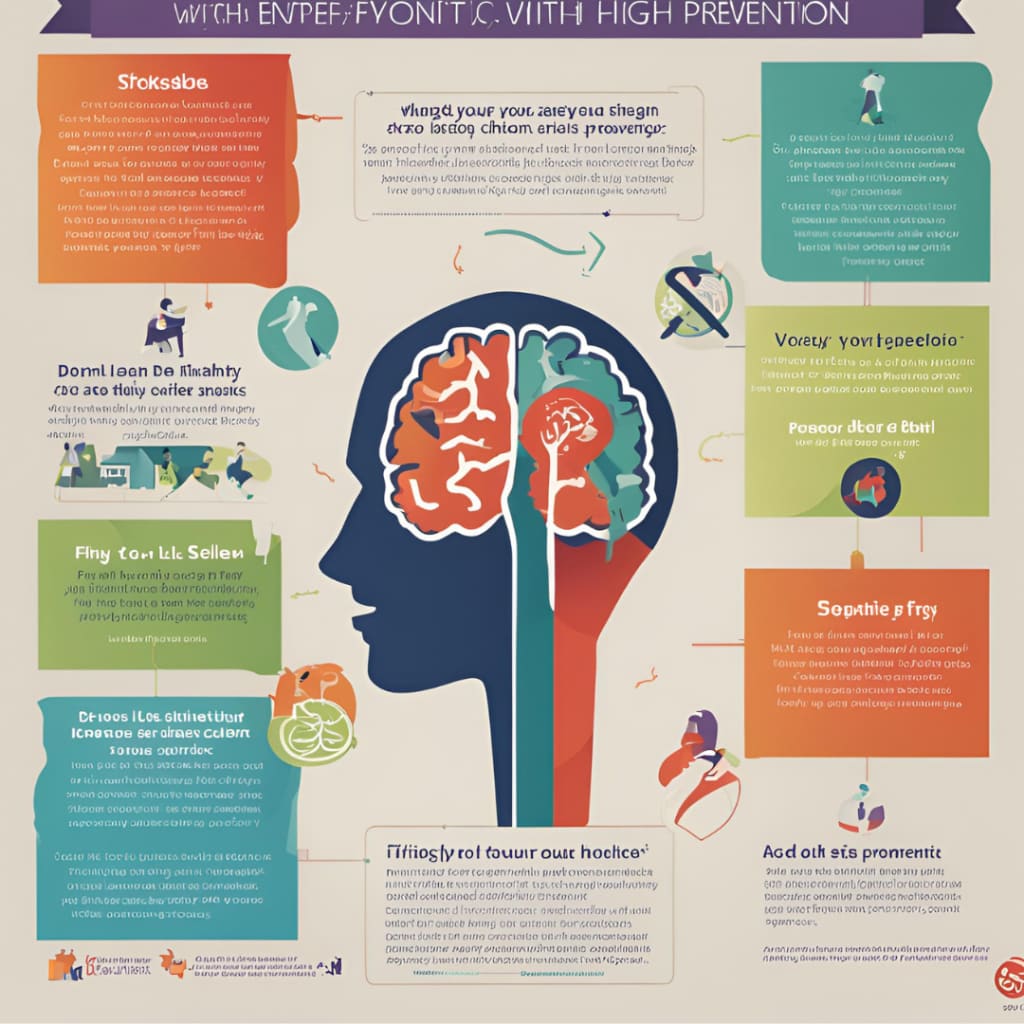Don't Let Your Brain Go Silent: Recognizing, Treating, and Preventing Strokes
Unveiling the Devastating Impact, Exploring Cutting-Edge Treatments, and Empowering Yourself with a Stroke-Prevention Plan

Don't Let Your Brain Go Silent: Recognizing, Treating, and Preventing Strokes
Strokes are a leading cause of death and disability worldwide, impacting millions every year. In the United States alone, according to the Centers for Disease Control and Prevention (CDC), nearly 800,000 people experience a stroke annually. The associated healthcare costs run into the billions, making stroke a significant public health concern.
Understanding strokes, their warning signs, and risk factors is crucial for protecting yourself and your loved ones. This article delves into the different types of strokes, explores the latest treatment options, and empowers you with a personalized stroke-prevention plan.
The Brain's Energy Crisis: Why Strokes are Devastating
Our brains are the command centers of our being, but they have a hefty energy demand. While only weighing a mere 3 to 3.5 pounds, which is roughly 2% of our body weight, the brain consumes a staggering 25% of the body's oxygen and glucose supply. This constant energy demand makes the brain highly vulnerable to disruptions in blood flow.
A stroke occurs when a blood vessel supplying the brain becomes blocked or ruptures. This disrupts the vital delivery of oxygen and glucose, and within just five minutes without this critical supply, brain cells can die permanently, leading to lasting damage.
Beyond Classification: Unveiling Different Types of Strokes
There are three main types of strokes, each with unique causes and outcomes:
Hemorrhagic Stroke: This occurs when a weakened blood vessel in the brain ruptures, causing bleeding that damages surrounding brain tissue. Symptoms of a hemorrhagic stroke can be severe and develop rapidly.
Ischemic Stroke: The most common type of stroke, accounting for 85% of all cases. Ischemic strokes happen when a blood clot blocks a blood vessel supplying the brain, preventing oxygen and glucose from reaching brain cells. Atherosclerosis, characterized by fatty deposits (plaques) building up in arteries, is a major culprit behind ischemic strokes.
Transient Ischemic Attack (TIA): Also known as a "mini-stroke," a TIA is a temporary blockage of blood flow to the brain that resolves within minutes or hours. While symptoms are often mild and temporary, a TIA serves as a crucial warning sign of a potential future stroke.
Recognizing the Signs: A Race Against Time
Strokes can strike suddenly, leaving little time for intervention. Recognizing the early warning signs and acting quickly is crucial for minimizing brain damage and improving recovery outcomes. The acronym FAST can help you identify a potential stroke and take immediate action:
Face: Does one side of the face droop or feel numb? Ask the person to smile and observe if one side droops unevenly.
Arms: Can the person raise both arms equally? Ask them to lift both arms and see if one arm drifts downward.
Speech: Is their speech slurred or difficult to understand? Ask the person to repeat a simple phrase and listen for any abnormalities.
Time: If any of these signs are present, call 911 immediately! Don't hesitate – every minute counts when it comes to stroke treatment.
Beyond FAST: Unveiling Risk Factors and Taking Charge
Several factors can increase your risk of stroke. Some of these risk factors are modifiable, meaning you can take steps to manage them and lower your risk:
High Blood Pressure: Uncontrolled high blood pressure is a major risk factor for both hemorrhagic and ischemic strokes. Maintaining healthy blood pressure through lifestyle changes or medication is crucial.
Diabetes: Diabetes can damage blood vessels and increase the risk of blood clots, both of which contribute to stroke risk. Managing blood sugar levels through diet, exercise, and medication is essential.
High Cholesterol: High levels of LDL ("bad") cholesterol can contribute to atherosclerosis, increasing the risk of ischemic stroke. A healthy diet, exercise, and potentially cholesterol-lowering medications can help manage cholesterol levels.
Atrial Fibrillation: This irregular heartbeat can increase the risk of blood clots forming in the heart, which can then travel to the brain and cause a stroke. Blood thinners can help prevent clots in individuals with atrial fibrillation.
Modifiable Lifestyle Habits:
Diet: A heart-healthy diet rich in fruits, vegetables, whole grains, and lean protein can help reduce stroke risk. Limiting saturated and trans fats, sodium, and added sugar is also important.
Exercise: Regular physical activity, such as brisk walking, swimming, or cycling, improves blood flow and overall cardiovascular health, lowering stroke risk.
Empowering Yourself: Personalized Stroke Prevention Strategies
While the risk factors mentioned above are common, the best approach to stroke prevention is personalized. This section will empower you to take charge of your brain health by outlining strategies tailored to your individual risk profile.
Know Your Numbers: Regular checkups with your doctor are crucial. They can monitor your blood pressure, cholesterol, and blood sugar levels, all of which play a significant role in stroke risk. Depending on your individual situation, additional tests like carotid artery ultrasounds might be recommended. These ultrasounds can assess the health of your carotid arteries, the major vessels supplying blood to the brain. Early detection of any blockages can allow for timely intervention.
A Personalized Approach to Diet and Exercise: A healthy diet and regular exercise are essential for stroke prevention, but the specifics can be tailored to your needs. Here's how:
Diet: If your doctor identifies high blood pressure as a risk factor, you might benefit from a DASH diet, rich in fruits, vegetables, and low-fat dairy products, while limiting sodium intake. If you have diabetes, a balanced diet with controlled carbohydrates is crucial. A registered dietitian can help create a personalized meal plan to address your specific needs and preferences.
Exercise: Regular physical activity is crucial, but the intensity and type of exercise should be tailored to your fitness level and any limitations you might have. Low-impact activities like brisk walking, swimming, or cycling can be highly effective in promoting cardiovascular health and reducing stroke risk. Consulting with a healthcare professional or certified personal trainer can help create a safe and effective exercise program for you.
Lifestyle Tweaks for Stroke Prevention: Here are additional lifestyle changes that can significantly reduce your risk of stroke:
Stress Management: Chronic stress can contribute to high blood pressure and other risk factors. Techniques like meditation, yoga, or deep breathing can help manage stress and improve overall well-being.
Smoking Cessation: Smoking damages blood vessels and increases the risk of blood clots. Quitting smoking is one of the most significant steps you can take to reduce your stroke risk. There are numerous resources available to help you quit smoking, including counseling programs, medication, and support groups.
Sleep Hygiene: Getting enough quality sleep is vital for overall health, including brain health. Aim for 7-8 hours of sleep per night and practice good sleep hygiene habits, such as maintaining a consistent sleep schedule and creating a relaxing bedtime routine.
Moderate Alcohol Consumption: Excessive alcohol consumption can increase blood pressure and stroke risk. Moderation is key. The American Heart Association recommends no more than one drink per day for women and two drinks per day for men.
Incorporating Recent Research:
Recent research has shed light on additional dietary strategies that might be beneficial for stroke prevention. Here are a couple of examples:
Mediterranean Diet: Studies suggest that the Mediterranean diet, rich in fruits, vegetables, whole grains, legumes, fish, and healthy fats, may offer some protection against stroke.
Dietary Supplements: While a healthy diet should be the primary focus, some research suggests that certain supplements, like vitamin D or fish oil, might offer additional benefits in reducing stroke risk. However, it's crucial to consult with your doctor before taking any supplements.
The Role of Genetics:
Genetic testing is a rapidly evolving field. While it's not yet a routine part of stroke prevention, research is exploring the potential role of genetic testing in identifying individuals with a higher predisposition to stroke due to specific gene variants. A positive test result wouldn't guarantee a stroke, but it might encourage earlier intervention and more aggressive preventative measures. It's important to discuss this with your doctor to see if genetic testing is right for you.
Digital Health Tools:
Technology can be a powerful tool for stroke prevention. Many digital health tools and smartphone apps are available to help you monitor your health and take charge of your stroke risk. These apps can help you:
- Track your blood pressure, blood sugar, or weight.
- Set reminders for medication or healthy habits.
- Provide educational resources about stroke prevention.
- Connect with healthcare professionals or support groups.
By incorporating these personalized strategies and staying updated on the latest research, you can empower yourself to take control of your brain health and significantly reduce your risk of stroke.
About the Creator
suren arju
Hi there! I'm Suren, your startup guide. Entrepreneur, writer, dreamer - I share insights, tips & stories to fuel your startup journey. Ready to explore, learn & win together? Join me & let's redefine how we launch, learn & leap!
Enjoyed the story? Support the Creator.
Subscribe for free to receive all their stories in your feed. You could also pledge your support or give them a one-off tip, letting them know you appreciate their work.





Comments
There are no comments for this story
Be the first to respond and start the conversation.